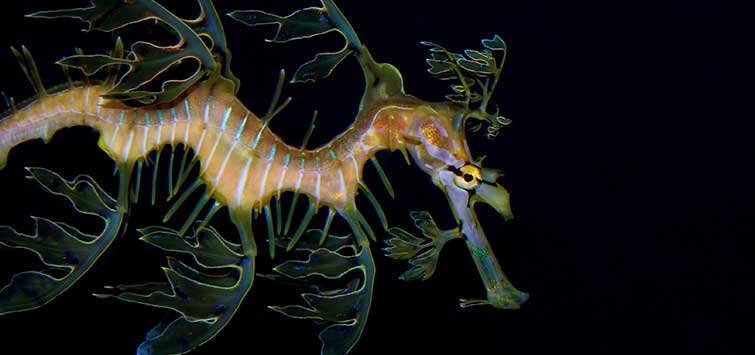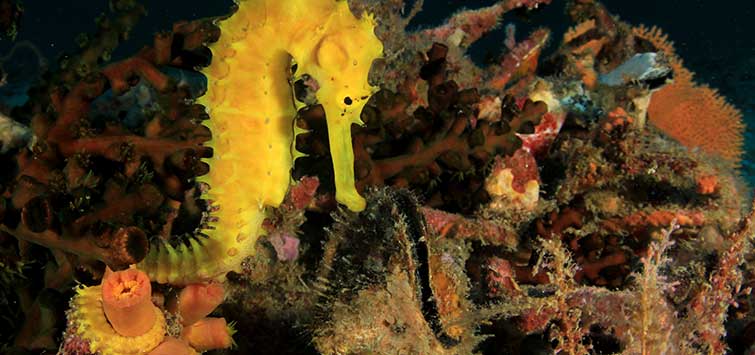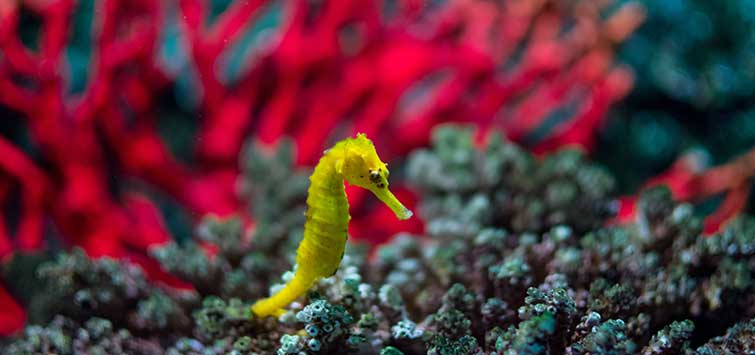Dreaming of Dragons
Author: Bob Goemans
They may not be the fire-breathing dragons of lore, but seadragons still look otherworldly enough to captivate aquarists and non-aquarists alike the world over. A longtime marine aquarist and writer delves into the world of seadragons, wonderful to observe in the wild and in public aquariums, even though you cannot keep them at home.
Not Those Dragons!
Does the title of this article bring to mind the mythological fire-breathing beasts of European and Chinese lore? Maybe so, but where aquarists are concerned, dragons are real, and they are found in the cool, 56° to 65°F waters of Southern and Western Australia.
Family
Seadragons belong to the family Syngnathidae, as do other tube-shaped-mouth fish such as seahorses and pipefish. The Greek roots of the family name refer to the fused jaws created by the interlocking plates of their tube-shaped mouths. It is believed they evolved from a common ancestor with bass, cichlids, perches, and sticklebacks during the Lower Tertiary Period, about 45 million years ago. Presently, the family Syngnathidae consists of about 215 species in 52 genera, with most found in marine environments, though some are found in fresh and brackish waters.
Appearance
Where seadragons are concerned, there are two species of special interest because of their bizarre appearance: those called weedy seadragons, Phyllopteryx taeniolatus, and those called leafy seadragons, Phycodurus eques. Their bodies are composed of many interlocking plates, which in turn form a sturdy exoskeleton/external skeleton covered with a skin-like membrane, not scales as with most fish. Actually, seadragons are more closely related to pipefish, as they swim in a horizontal fashion and do not have a prehensile tail like the seahorses, which swim in more of a vertical fashion. One could say the weedy seadragon seems to glide through water, whereas the leafy seadragon moves forward with somewhat of a rocking-horse motion.
In the Wild
In the wild, both are found in somewhat shallow rocky reefs at 50- to 70-foot depths, where seaweed/kelp and algae abound. They blend in quite easily in these types of areas, as the weed-like appendages on their bodies match the surrounding natural growths. Judging by their names one might think the weedy seadragon would have more appendages than the leafy seadragon, but that is false, as the leafy has far more. They generally feed upon small fish and crustaceans, which are vacuumed into their tube-like snouts with the help of a bag-like growth beneath the jaw that opens very quickly, causing a suction to occur in the snout. This in turn quickly sucks in the prey, which is often mysid shrimp, their favorite.
Breeding
Both species tend to be solitary or live in mated pairs until springtime, when they form large congregations in weedy areas to mate. As with seahorses, the male gets pregnant and gives birth to little replicas of himself, but in contrast, the eggs are not placed into a pouch on the male by the female, but instead are glued onto the underside of the male’s tail.
Courtship
There’s a lot of contact during courtship, and seadragons may gently shove one another in different directions with their heads and tails arched away from each other. This appears to be a ritualistic dance that forms a bond between couples. While this courtship occurs, the female is developing about 250 orange-colored, pear-shaped eggs in the lower abdominal area. At the same time, the male is developing small, swelled blood vessels in many cup-like structures on the lower side of his tail.
Transferring Eggs
When the right time comes to transfer the eggs, usually around August or September, the female transfers the still-to-be-fertilized eggs via a tube onto the spongy area under the tail of the male, where they are then fertilized. There is some thought that if the female does not fully cover the male’s spongy area with eggs, another female will approach the male and deposit some of her eggs until the area is fully covered (Whitley & Allen, 1958).
Over the next two months, the male transfers dissolved oxygen and other needed substances via the swelled blood vessels in this spongy area to the developing fry inside the eggs. When the fry are ready to be dispatched (measuring about 20 mm at this point) into surrounding waters, the male will stagger their release over several days to prevent them from being eaten by predators all at once.
Fry Release
As for the fry release, the male pumps/twists his tail, and/or rubs it against strands of kelp or rocks to loosen them. They feed upon zooplankton, and about a year later they attain an 8-inch length where mysid shrimp now becomes a staple food. They reach their mature length another year later. From what I can gather, their lifespan in the wild is still to be determined, but as captive specimens they have proven not to be long lived, with four to eight years being their average lifespan.
Leafy Seadragon
As mentioned above, there are two species of special interest. The leafy seadragon Phycodurus eques, the only species in its genus, has an average length of about 12 inches. Nevertheless, some have been found to exceed that, with some reaching 17 inches or possibly slightly more.
The leafy seadragon propels itself with the pectoral fin located on the ridge of its neck and the dorsal fin on its back, which are both clear and difficult to see, giving the illusion it’s just a floating mass of seaweed/kelp, not a living animal. The official marine emblem of the state of South Australia, they are presently said to be found along the southern Australian coastline from Geraldton in Western Australia to Wilsons Promontory in Victoria, generally at depths of about 20 to 60 feet, yet sometimes as deep as 160 feet. Their main diet consists of small fish and crustaceans. I should add that distribution range appears to be changing somewhat, though, as updated searches have found them in slightly wider areas.
Camouflage
These have far more leaf-like appendages than do weedy seadragons, which makes them look exactly like the brown kelp growths Macrocystis pyrifera and Ecklonia radiata in surrounding areas, helping to camouflage them from predators. One can safely say their appendages are one of the most astounding examples of animal camouflage. The kelp also limits the currents in these areas, thereby helping these weak-swimming seadragons go about their business.
Generally, adults are green to yellow-brown in color with thin, pale, dark-edged bands. And depending upon their age, stress level, nutrition, or location, they can change color to match surrounding areas. There are also long, strong spines along the sides and bottom of the body that can be used to protect the fish from attacking predators. They also have the ability to return to exactly the same home spot after venturing out long distances in search of food.
Weedy Seadragon
The common or weedy seadragon Phyllopteryx taeniolatus grows to about 18 inches and has far fewer appendages than the leafy seadragon. Their appendages are also shorter in length and are basically dark green and edged with black. The adults are usually reddish with yellow spots and have purple/blue stripes that run diagonally down the sides of the front body. The male has a more shallow body width and is usually a darker color than the female. Weedies hail from Geraldton in Western Australia along the southern Australian coastline, including Tasmania to Port Stephens in New South Wales.
Ribboned Seadragon
There just happens to be another species that is sometimes called a seadragon: the ribboned seadragon/pipefish Haliichthys taeniophorus. It’s really more of a pipefish-seahorse, often called a pipehorse since it has an angled head, a prehensile tail, and a linear body similar to a pipefish, and males carry eggs in a brood pouch under the tail.
It differs not only in appearance from the leafy and weedy seadragons because it looks more like a pipefish with a few appendages, but it is actually found in tropical reef and coastal waters and seagrass beds where it attains lengths up to about 12 inches. It’s also sometimes called the slender tanglefish. It has a natural range from Irian Jaya in New Guinea, through the Torres Strait and coast of Northern Australia to Shark Bay and Western Australia. It was successfully captive-bred by the Dallas World Aquarium in late 2006.
Don’t Try Them at Home
As with many hobbyist-desired animals or those wanted for traditional medicines, such as shark fins or seahorses, there’s a commercial market for seadragons. Therefore, there is concern for the future of these animals. When one realizes there are over 20 countries involved in the harvesting of about 20 million seahorses and pipefish each year for the Asian medicine market, concern grows for the very limited range that seadragons encompass. And though they are not harvested for the aquarium trade, unscrupulous collectors seek them out in hopes of finding males carrying eggs during the breeding season, so they can hatch and sell the fry to the rare hobbyist that will leave no stone unturned to own a seadragon. Shameful is the best way to describe such behavior.
Are you still dreaming of having your own seadragons? Well, dream on—you’re not alone! And I should mention that several hobbyists have contacted me (two have called me at home, in fact) over the years wanting to know where they could obtain a seadragon. Unfortunately, the answer has always been, and remains to this very day: Only public aquariums or private research institutions working towards breeding them have availability to these bizarre-looking creatures. In fact, the export of these seadragons is strictly regulated, as they are protected by the Convention on International Trade in Endangered Species of Wild Fauna and Flora (CITES). Therefore, hobbyists cannot obtain leafy or weedy seadragons, and they will have to visit public aquariums to see these fascinating close relatives to seahorses and pipefish.
As we progress in this hobby, the day could arrive that captive-bred seadragon specimens will become available. Until then, we can only dream about one day being able to keep these magnificent creatures.
References & Further Reading
Connolly, Roderick M. 1998. “Measuring the Home Range of Leafy Seadragons.” The Dragon’s Lair 3(2):3.
Connolly, Roderick M., Andrew J. Melville, and John K. Keesing. 2002. “Abundance, Movement and Identification of Individual Leafy Sea Dragons, Phycodurus eques (Pisces: Syngnathidae).” Marine and Freshwater Research 53(4):777–780.
Connolly, Roderick M., Andrew J. Melville, and Keith M. Preston. 2002. “Patterns of Movement and Habitat Use by Leafy Seadragons Tracked Ultrasonically.” Journal of Fish Biology 61(3):684–695.
Dragon Search: www.dragonsearch.asn.au
Gomon, Martin F., J. C. M Glover, and R. H. Kuiter. 1994. The Fishes of Australia’s South Coast. State Print. Adelaide, Australia. 994 pp.
Groves, P. 1998. “Leafy Sea Dragons.” Scientific American 279(6):54–59.
Jones, G. P., and U. L. Kaly. 1995. “Conservation of Rare, Threatened and Endemic Marine Species in Australia.” State of the Marine Environment Report for Australia: The Marine Environment - Technical Annex: 1. Department of the Environment, Sport and Territories. Canberra, Australia. 183–191 pp.
Kuiter, Rudie H. 1993. Coastal Fishes of South-Eastern Australia. University of Hawai‘i Press. Honolulu, Hawai‘i. 448 pp.
Kuiter, Rudie H. 2000. Coastal Fishes of Southeastern Australia. Gary Allen. Sydney, Australia. 437 pp.
Kuiter, Rudie H. 2001. Seahorses, Pipefishes and their Relatives. A Comprehensive Guide to Syngnathiformes. TMC Publishing. Chorleywood, UK. 240 pp.
Mackay, Bruce. 1998. “Seadragons in Wild and Captive Environments.” Today’s Aquarist 7(2):5–9.
Zahl, Paul A. 1978. “Dragons of the Deep.” National Geographic 153(6):38–45.
See the full article on TFH Digital http://www.tfhdigital.com/tfh/200905/#pg93

.png?h=595&iar=0&w=2781&hash=5FD5E69473BCC22199FBFA2FB71B6033)



